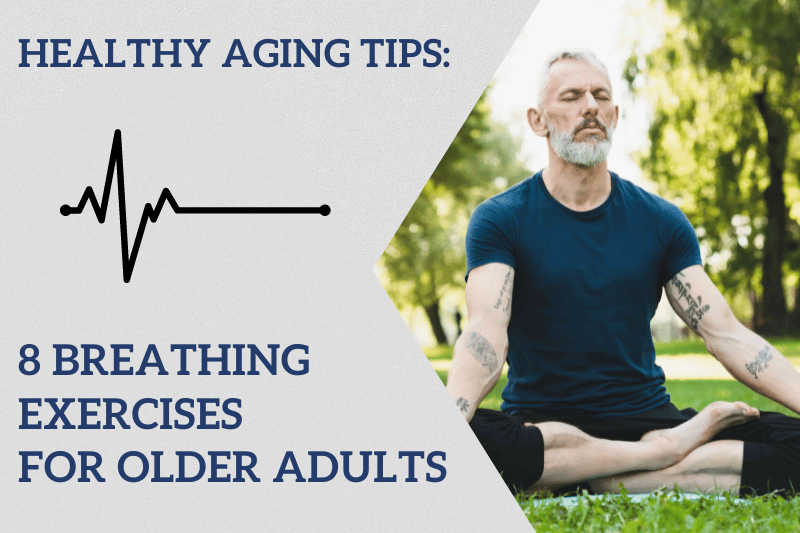As we age, our lungs and the muscles responsible for adequate breathing weaken. This often results in breathing difficulties that could likely become worse over time.
Breathing exercises for seniors are efficient ways to combat respiratory problems like chronic obstructive pulmonary disease (COPD), asthma, shortness of breath, and more.
By the end of this article, you will have mastered several simple breathing exercises that can help you exchange oxygen and carbon dioxide more efficiently through your lungs.
Benefits of Breathing Exercises

Healthy aging doesn't come easy. It requires some work. And while breathing seems easy, breathing exercises can help to keep you healthy.
We all know breathing is essential to life, but it's so much more than that. How well you breathe can affect your strength, stamina, sleep, and mood. Below are more benefits.
- It reduces stress and anxiety: Proper breathing can help older adults to cope with stress more efficiently. Exercises like deep breathing activate the body's relaxation response, leading to reduced stress hormones and a sense of calm.
- It may increase lung capacity: As we age, our lung capacity may decrease. Breathing exercises can help maintain or improve lung function by promoting better oxygen exchange and increasing the efficiency of the respiratory muscles.
- It improves digestion: Deep breathing exercises can stimulate the parasympathetic nervous system, which promotes relaxation and aids in digestion. It is especially beneficial if you experience digestive issues.
- It improves sleep and mood: Practicing healthy breathing before bed can help you relax your body and mind, leading to more quality sleep. It can also trigger endorphins and other feel-good chemicals in the brain, leading to improved mood and a reduced risk of depression. It calms your mind.
- It improves your posture: Practicing breathing can also help you maintain musculoskeletal health and prevent discomfort or pain.
- Better Oxygenation: Breathing exercises enhance oxygen intake and distribution throughout your body. This increased oxygenation can improve energy levels, cognitive function, and overall vitality.
The benefits of breathing exercises are numerous, and according to the National Institutes of Health, controlled breathing can be especially beneficial for older adults.
Older adults who don't take the time to breathe deeply can experience ribcage stiffness and muscle weakness, which leads to shallow breaths and a poor oxygen supply.
Shallow breathing can make you feel sluggish and uncomfortable and may even prevent you from maintaining an active lifestyle.
However, just like many functions of your body, lung strength can be significantly improved with regular exercise.
Here, we look at some breathing exercises for older adults.
The Best Breathing Exercises For Seniors

Below are some breathing exercises that can help you maintain healthy lungs and generally improve your health.
1. Complete Breathing
Complete breathing, or three-part breath, is a technique that engages the diaphragm, lower ribcage, and upper chest to achieve a deep and thorough breath. It covers both belly breathing (abdominal breathing) and chest breathing.
Here's how to do it:
- Sit up straight and exhale.
- Start breathing in and relax your stomach muscles.
- Feel your belly expand as your lungs fill with air.
- Keep breathing in until you feel your chest expand with a deep breath.
- Hold your breath briefly and exhale slowly, pulling your belly in to feel the last bit of air leaving your lungs.
- Close your eyes, relax, and focus on breathing like this for five minutes every day.
2. Pursed-Lip Breathing
Pursed-lip breathing is an excellent morning breathing exercise that slows down your breathing and improves lung function. It is beneficial if you're easily short of breath.
Here's how to do it:
- Stretch and take a deep breath through your nose. Hold your breath for a count of two.
- Purse your lips as if you were going to blow out a candle.
- Exhale slowly and evenly through pursed lips for a count of four.
- Repeat this pattern for two to three minutes.
3. Humming Breathing
Humming breathing is a yoga breathing exercise that involves humming while exhaling. This practice offers various physical, mental, and emotional benefits.
Here's how to do it:
- Follow the instructions for complete breathing,
- But when you exhale, hum as you release the air from your body.
- Pull your belly muscles in as you hum the last air from your lungs.
- Relax and practice this exercise two to three times.
4. Chinese breathing
This exercise comes from the Chinese practice of Tai Chi Chuan.
Here's how to do it:
- Take three short breaths in.
- Raise your arms shoulder height in front of you on the first breath.
- Pull your arms to shoulder height at your sides on your second breath.
- Raise them above your head on the last breath.
- Then slowly exhale and lower your arms back down to your sides.
- Try 10-12 repetitions. If you get light-headed, stop the exercise.
5. Diaphragmatic Breathing
This exercise promotes relaxation and strengthens the diaphragm muscles for more efficient breathing.
Here's how to do it:
- The easiest way to practice this exercise is to lie on your back.
- Place one hand over your navel and your other hand above it on your stomach.
- Now concentrate on breathing from your diaphragm.
- If you can see the hand over your navel rising before the hand above it, you are doing this exercise correctly.
- Relax and keep breathing for five minutes.
6. Feet Breathing
This is as much a relaxation technique as it is a breathing exercise. Concentrate on breathing as your chest and diaphragm rise and fall in tandem.
Breathe at a regular speed and allow yourself to clear your mind. As you exhale, imagine your stress and tension traveling down your body and leaving through your feet.
Repeat until you feel relaxed.
7. Buteyko Breathing
This breathing exercise is especially helpful for people with breathing problems like asthma. Start by finding a comfortable resting position in a quiet place, and instead of taking a deep breath, concentrate on taking shallow breaths slowly through your nose.
This method can slow the cycle of rapid, gasping breaths people experience with an asthma attack or in a stressful situation.
8. Breathing While In Pain
It's difficult to breathe correctly when in pain. This is because our bodies assume that we can limit pain and discomfort when we hold our breath.
However, this only increases the pain by increasing our stress response.
Here's the proper way to breathe when in pain:
- Get in a comfortable position in a quiet place.
- Inhale as deeply and slowly as you can.
- Fill your abdomen with air while keeping your head relaxed and focused.
- Slowly clear your airway by exhaling.
- Repeat the process until it's easier to breathe in a more controlled manner.
Final Words

Note that while these breathing techniques can improve overall respiratory health and help you breathe easier, you must stay consistent.
Practice these daily exercises for better results and lead a healthier life.












